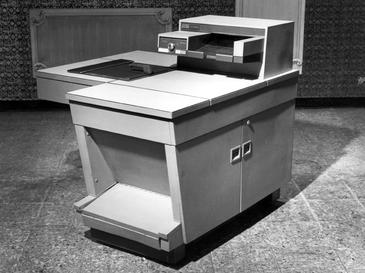The Xerox 914, unveiled on September 16, 1959, marked a pivotal moment in office technology. This groundbreaking machine revolutionized document reproduction, setting new standards for speed, convenience, and accessibility in the workplace.
Before the 914’s arrival, copying documents was a tedious and messy process. Workers often relied on carbon paper, which required careful placement between sheets and resulted in low-quality duplicates.
The introduction of the Xerox 914 changed this landscape dramatically.
Key features of the Xerox 914 included:
- Plain paper usage
- Button-operated simplicity
- Ability to copy documents up to 9″ x 14″ in size
- Rental availability for businesses
These attributes made the 914 an attractive option for offices seeking to streamline their document management processes. The machine’s user-friendly design allowed even those with minimal training to produce high-quality copies quickly.
The journey to create the Xerox 914 was long and challenging. Chester Carlson, the inventor behind the xerographic process, faced numerous setbacks and rejections over two decades.
His persistence and dedication to improving office efficiency ultimately led to the development of this groundbreaking technology.
Carlson’s early experiments, conducted in his home kitchen, involved hazardous materials and unpleasant odors. These trials often resulted in family disputes and neighborhood complaints.
Despite these obstacles, Carlson continued refining his ideas, drawing inspiration from scientific literature and his own experiences in patent offices.
The road to success was not smooth:
| Year | Event |
|---|---|
| 1938 | Carlson achieves first xerographic copy |
| 1939-1944 | 20 companies reject Carlson’s invention |
| 1946 | Battelle Memorial Institute signs agreement |
| 1948 | Haloid releases Xerox Model A Copier (39 steps per copy) |
| 1959 | Xerox 914 introduced |
The Xerox 914’s impact extended beyond its technological achievements. It transformed office dynamics and productivity.
The machine’s capabilities led to the creation of dedicated copy rooms in many businesses, staffed by trained operators who managed copy requests and machine maintenance.
While the 914 represented a significant advancement, it was not without flaws. Early models were prone to overheating, sometimes resulting in small fires.
This issue was so common that the machine came equipped with a “scorch eliminator” – a fire extinguisher in disguise. Paper jams, referred to as “mispuffs,” were also frequent occurrences.
Despite these challenges, the Xerox 914’s benefits far outweighed its drawbacks. The machine’s ability to produce clear copies on standard paper without damaging originals was a game-changer for businesses and institutions worldwide.
Xerox’s marketing strategy for the 914 focused on its ease of use. Television advertisements featured a young girl named Debbie effortlessly making copies, emphasizing the machine’s simplicity. This approach resonated with businesses looking to improve office efficiency.
The success of the Xerox 914 had far-reaching effects:
- It established Xerox as a leader in office technology
- It paved the way for future innovations in copying and printing
- It changed how businesses handled document reproduction and distribution
The xerographic process developed by Carlson for the 914 laid the foundation for modern laser printing technology. This connection highlights the long-lasting impact of Carlson’s work on office technology.
Chester Carlson’s story serves as an inspiration for aspiring inventors and entrepreneurs. His journey from patent clerk to successful inventor spanned decades, demonstrating the importance of perseverance in innovation.
Carlson’s experience challenges the notion of overnight success, showing that groundbreaking inventions often require years of dedication and refinement.
After achieving success with the Xerox 914, Carlson used his wealth to support various causes. He made anonymous donations to organizations focused on civil liberties, racial equality, and Buddhism. His philanthropic efforts reflected a commitment to social progress that extended beyond his technological contributions.









